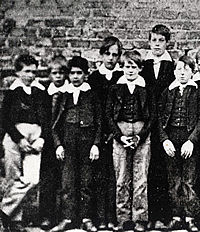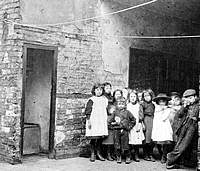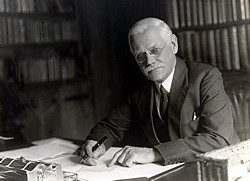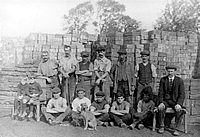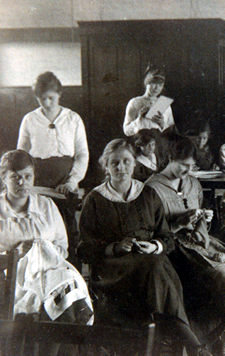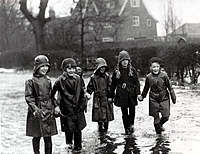In 1899, Joseph Rowntree’s study in York highlights low wages, unemployment and old age as principle causes of poverty. For Joseph and his son, Seebohm, searching for better ways of tackling poor living conditions and social disadvantage is a core concern.
What holds us back today? And how can work help or hinder us?
What holds us back?
For Joseph Rowntree tackling poverty is not about simply giving money to solve the immediate problem, it is about dealing with the “underlying causes”. In 1904, he writes “The Soup Kitchen in York never has difficulty in obtaining adequate financial aid, but an enquiry into the extent and causes of poverty would enlist little support,” in his founding memorandum for the Foundation and its sister trusts.
In his 1901 study of York, Poverty: A study of town life, Seebohm Rowntree argues that poverty is a direct result of low wages, contradicting a common view that poor people were responsible for their own situation. His study marks the beginning of a period in which research has a growing impact on the development of social policies. It is also highly influential in establishing a statistical and scientific approach to the measurement of poverty. At the beginning of the 1990s, the Foundation supports the ‘Breadline Britain’ television series and work by Jonathan Bradshaw on ‘budget standards’; it continues to play a key part in the debate on how to measure poverty.
In 1901, half the nation’s income is going to one-ninth of its population. Ways of boosting income develop over the twentieth century. In 1906, the Liberal Government sets in train ambitious reforms to combat poverty. Following William Beveridge’s report – much influenced by Seebohm Rowntree – the post-war Attlee Government introduces ‘social security’, designed to protect the population from ‘cradle to grave’.
In the 1960s, work for the Foundation by Peter Townsend highlights the continuing extent of family poverty. This helps raise the profile of poverty – particularly as it affects children – into the 1970s. But the JRF Inquiry into Income and Wealth finds income inequality in the UK growing rapidly between 1977 and 1990, reaching the highest level since the Second World War. In 2003, check-out operators – the lowest paid full-time employees – are earning £208 a week: by contrast, at the top of the earnings league, ‘directors and chief executives of major organisations’ earn £2,301 a week. The Government introduces new tax credits to help boost the income of those in work. How effective will these be?
Over the century notions of what constitutes ‘poverty’ broaden. In the 1940s, the creation of the welfare state is informed by the five 'Giant Evils' – Want, Disease, Ignorance, Squalor and Idleness – identified by Beveridge. The new 1997 Labour Government sets up a ‘social exclusion’ unit to tackle the complex interaction of different forms of disadvantage. One hundred years after Seebohm’s report, a series of JRF studies tracks whether the Government is achieving its goals of combating poverty and social exclusion. And the Foundation’s research programme on Poverty and Disadvantage continues to examine this multi-dimensional nature of poverty.
The picture is complex. People move in and out of poverty. Particular groups – lone parents, children, people from minority ethnic communities, disabled people – may be at particular risk of poverty. Rural communities too face special challenges. At the end of 2003, work from the LSE suggests the Government will meet its short-term target for reducing child poverty. But it warns that achieving the longer-term target of eradicating child poverty ‘within a generation’, will be more difficult.
And inequalities may become self-perpetuating. Whole neighbourhoods face disadvantage – and stigma – which can last generations. Those with the least money have the fewest options for managing it, though experiments with innovative solutions continue. Money aside, there are inequalities in educational achievement, health, even in death.
New problems emerge. People on low incomes are especially vulnerable to environmental problems. But policies designed to benefit the environment can conflict with the social and economic well-being of people on low incomes. In 2000, the JRF sets up a programme looking at reconciling these tensions.
What other steps will be needed in the next twenty years to ensure the poorest groups in society achieve a fairer share of the nation’s growing prosperity? To mark its centenary, the Foundation aims to stimulate debate on this central challenge. Studies suggest that reducing relative poverty to a minimum will not be easy, but it could be achieved.
How we work
The 1901 Census finds 84 per cent of men and boys over 10 working, mostly in agriculture, manufacturing, mining and transport. Less than a third of women are in paid work, half of these working as domestic servants. Every month, over 300 people are killed and 8-10,000 injured in industrial accidents. But work is changing. Communications is a significant growth industry: employment in the telegraph and telephone services has risen by half in a decade, many of the new jobs going to women.
By the start of the next century, equal numbers of men and women are working, although many women have part-time jobs. Health and safety have improved dramatically: 251 workers are fatally injured in 2002/03. But new stresses are emerging, particularly for families. For some it may be more difficult to find work; some face more than one disadvantage.
Traditional patterns of 9-5 working have changed. Flexible working brings benefits but also stresses. Once again, communications industries are seeing a spurt of growth. New industries demand new skills and new attitudes. Young men may find themselves at a disadvantage. And not everyone is part of the digital age: are new divisions emerging?
Find out more about the Foundation’s housing operations, current research priorities and how it is working to effect change.


